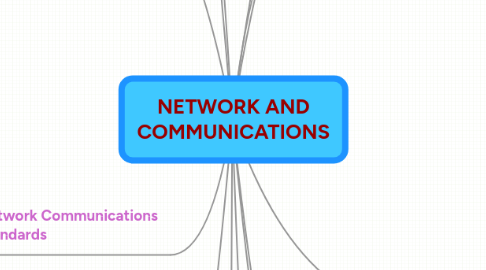NETWORK AND COMMUNICATIONS
作者:Nicky Daniel

1. Communications
1.1. Computer communications describes a process in which two or more computers or devices transfer data, instructions, and information
2. Video: Got Your Video Right Here
3. Communications Channel
3.1. The amount of data that can travel over a communications channel sometimes is called the bandwidth
3.2. Latency is the time it takes a signal to travel from one location to another on a network
3.3. Transmission media carries one or more signals
3.4. Broadband media transmit multiple signals simultaneously
4. Communications Software
4.1. Communications software consists of programs that
4.1.1. Help users establish a connection to another computer or network
4.1.2. Manage the transmission of data, instructions,and information
4.1.3. Provide an interface for users to communicate with one another
5. Networks
5.1. network in computer science is a group of computers and associatd devices that connected by communications facilities
5.2. Advantages of a network include
5.2.1. Facilitating communications
5.2.2. Sharing hardware
5.2.3. Sharing data and information
5.2.4. Sharing software
5.2.5. Transferring funds
5.3. A local area network (LAN) is a network that connects computers and devices in a limited geographical area
5.4. A wireless LAN (WLAN) is a LAN that uses no physical wires
5.5. A metropolitan area network (MAN) connects LANs in a metropolitan area
5.6. A wide area network (WAN) is a network that covers a large geographical area
5.7. The design of computers, devices, and media on a network is sometimes called the network architecture
5.8. P2P describes an Internet network on which users access each other’s hard disks and exchange files directly over the Internet
5.9. A network topology refers to the layout of the computers and devices in a communications network
6. Physical Transmission Media
7. Home Networks
7.1. Types of wired home networks
7.1.1. Ethernet
7.1.2. Powerline cable
7.1.3. Phoneline
8. why network is needed
8.1. recource sharing
8.2. reliability
8.3. reduced cost
8.4. fast communication
9. Network Communications Standards
9.1. Ethernet
9.2. Token ring
9.3. TCP/IP
9.4. Wi-Fi
9.5. Bluetooth
9.6. UWB
9.7. IrDA
9.8. RFID
9.9. WAP
10. NICKY SUMMER ANAK DANIEL DB220109
11. Wireless Transmission Media
11.1. Cellular radio is a form of broadcast radio that is used widely for mobile communications
11.2. Microwaves are radio waves that provide a highspeed signal transmission
11.3. A communications satellite is a space station that receives microwave signals from an earth-based station, amplifies it, and broadcasts the signal over a wide area
12. Uses of Computer Communications
12.1. Users can send and receive wireless messages using wireless messaging services
12.2. Wireless Internet access points allow people to connect wirelessly to the Internet from home, work, school, and in many public locations
12.3. A cybercafé is a coffeehouse, restaurant, or other location that provides personal computers with Internet access to its customers
12.4. A global positioning system (GPS) is a navigation system that consists of one or more earth-based receivers that accept and analyze signals sent by satellites in order to determine the GPS receiver’s geographic location
12.5. GPS receivers
12.6. Collaboration software includes tools that enable users to share documents via online meetings and communicate with other connected users
12.7. Web services enable programmers to create applications that communicate with other remote computers over the Internet or on an internal business network
12.8. A mashup is a Web application that combines services from two or more sources
13. Communications Devices
13.1. A communications device is any type of hardware capable of transmitting data, instructions, and information between a sending device and a receiving device
13.2. A dial-up modem converts signals between analog and digital
13.3. A digital modem sends and receives data and information to and from a digital line
13.4. A wireless modem uses the cell phone network to connect to the Internet wirelessly from a notebook computer, a smart phone, or other mobile device
13.5. A network card enables a computer or device to access a network
13.6. Available in a variety of styles
13.7. Wireless network cards often have an antenna
13.8. A wireless access point is a central communications device that allows computers and devices to transfer data wirelessly among themselves or to a wired network
13.9. A router connects multiple computers or other routers together and transmits data to its correct destination on a network
13.10. Many are protected by a hardware firewall
13.11. A hub or switch connects several devices in a network together
14. Communications Over the Telephone Network
14.1. The public switched telephone network (PSTN) is the worldwide telephone system
14.2. ADSL connections transmit data downstream at a much faster rate than upstream


